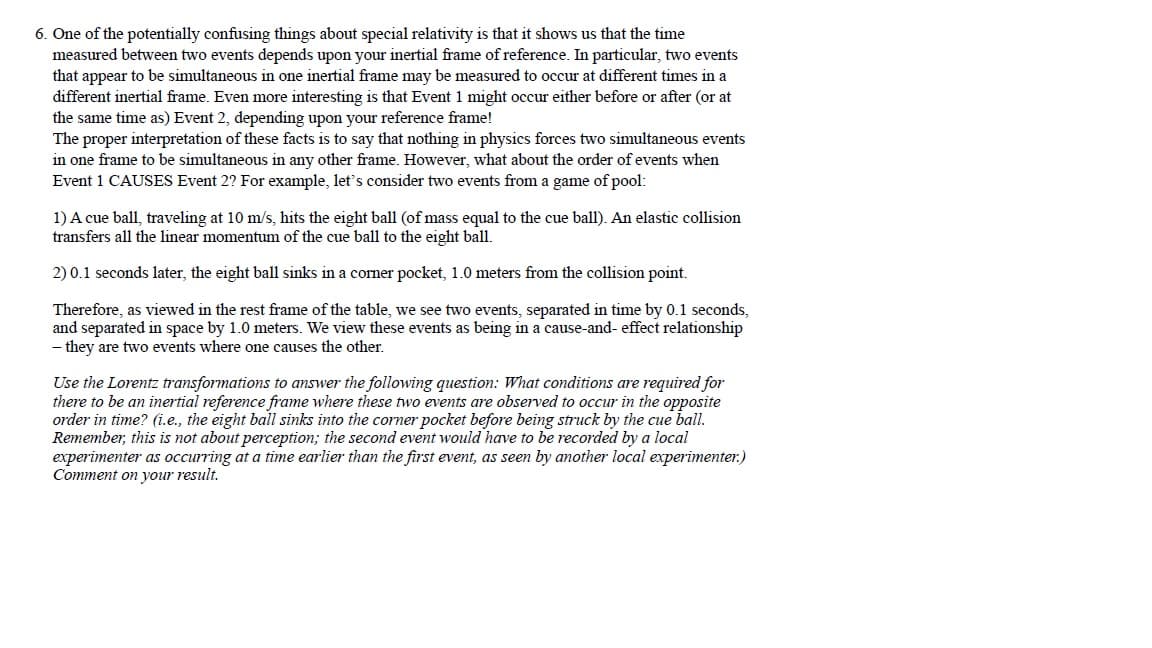6. One of the potentially confusing things about special relativity is that it shows us that the time measured between two events depends upon your inertial frame of reference. In particular, two events that appear to be simultaneous in one inertial frame may be measured to occur at different times in a different inertial frame. Even more interesting is that Event 1 might occur either before or after (or at the same time as) Event 2, depending upon your reference frame! The proper interpretation of these facts is to say that nothing in physics forces two simultaneous events in one frame to be simultaneous in any other frame. However, what about the order of events when Event 1 CAUSES Event 2? For example, let's consider two events from a game of pool: 1) A cue ball, traveling at 10 m/s, hits the eight ball (of mass equal to the cue ball). An elastic collision transfers all the linear momentum of the cue ball to the eight ball. 0oondc lotor the gicht bol1 10 from the collision noint
6. One of the potentially confusing things about special relativity is that it shows us that the time measured between two events depends upon your inertial frame of reference. In particular, two events that appear to be simultaneous in one inertial frame may be measured to occur at different times in a different inertial frame. Even more interesting is that Event 1 might occur either before or after (or at the same time as) Event 2, depending upon your reference frame! The proper interpretation of these facts is to say that nothing in physics forces two simultaneous events in one frame to be simultaneous in any other frame. However, what about the order of events when Event 1 CAUSES Event 2? For example, let's consider two events from a game of pool: 1) A cue ball, traveling at 10 m/s, hits the eight ball (of mass equal to the cue ball). An elastic collision transfers all the linear momentum of the cue ball to the eight ball. 0oondc lotor the gicht bol1 10 from the collision noint
Physics for Scientists and Engineers, Technology Update (No access codes included)
9th Edition
ISBN:9781305116399
Author:Raymond A. Serway, John W. Jewett
Publisher:Raymond A. Serway, John W. Jewett
Chapter39: Relativity
Section: Chapter Questions
Problem 39.9OQ: Which of the following statements are fundamental postulates of the special theory of relativity?...
Related questions
Question

Transcribed Image Text:6. One of the potentially confusing things about special relativity is that it shows us that the time
measured between two events depends upon your inertial frame of reference. In particular, two events
that appear to be simultaneous in one inertial frame may be measured to occur at different times in a
different inertial frame. Even more interesting is that Event 1 might occur either before or after (or at
the same time as) Event 2, depending upon your reference frame!
The proper interpretation of these facts is to say that nothing in physics forces two simultaneous events
in one frame to be simultaneous in any other frame. However, what about the order of events when
Event 1 CAUSES Event 2? For example, let's consider two events from a game of pool:
1) A cue ball, traveling at 10 m/s, hits the eight ball (of mass equal to the cue ball). An elastic collision
transfers all the linear momentum of the cue ball to the eight ball.
2) 0.1 seconds later, the eight ball sinks in a corner pocket, 1.0 meters from the collision point.
Therefore, as viewed in the rest frame of the table, we see two events, separated in time by 0.1 seconds,
and separated in space by 1.0 meters. We view these events :
- they are two events where one causes the other.
being in a cause-and- effect relationship
Use the Lorentz transformations to answer the following question: What conditions are required for
there to be an inertial reference frame where these two events are observed to occur in the opposite
order in time? (i.e., the eight ball sinks into the corner pocket before being struck by the cue ball.
Remember, this is not about perception; the second event would have to be recorded by a local
experimenter as occurring at a time earlier than the first event, as seen by another local experimenter.)
Comment on your result.
Expert Solution
This question has been solved!
Explore an expertly crafted, step-by-step solution for a thorough understanding of key concepts.
This is a popular solution!
Trending now
This is a popular solution!
Step by step
Solved in 3 steps with 2 images

Knowledge Booster
Learn more about
Need a deep-dive on the concept behind this application? Look no further. Learn more about this topic, physics and related others by exploring similar questions and additional content below.Recommended textbooks for you

Physics for Scientists and Engineers, Technology …
Physics
ISBN:
9781305116399
Author:
Raymond A. Serway, John W. Jewett
Publisher:
Cengage Learning


Physics for Scientists and Engineers: Foundations…
Physics
ISBN:
9781133939146
Author:
Katz, Debora M.
Publisher:
Cengage Learning

Physics for Scientists and Engineers, Technology …
Physics
ISBN:
9781305116399
Author:
Raymond A. Serway, John W. Jewett
Publisher:
Cengage Learning


Physics for Scientists and Engineers: Foundations…
Physics
ISBN:
9781133939146
Author:
Katz, Debora M.
Publisher:
Cengage Learning

College Physics
Physics
ISBN:
9781938168000
Author:
Paul Peter Urone, Roger Hinrichs
Publisher:
OpenStax College

College Physics
Physics
ISBN:
9781285737027
Author:
Raymond A. Serway, Chris Vuille
Publisher:
Cengage Learning

College Physics
Physics
ISBN:
9781305952300
Author:
Raymond A. Serway, Chris Vuille
Publisher:
Cengage Learning